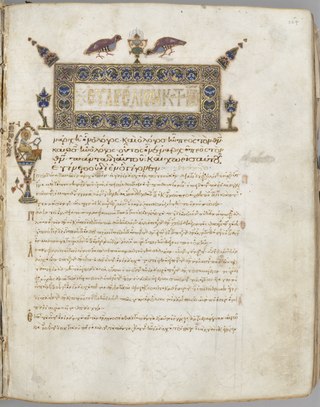
An illuminated manuscript is a formally prepared document where the text is often supplemented with flourishes such as borders and miniature illustrations. Often used in the Roman Catholic Church for prayers, liturgical services and psalms, the practice continued into secular texts from the 13th century onward and typically include proclamations, enrolled bills, laws, charters, inventories and deeds.
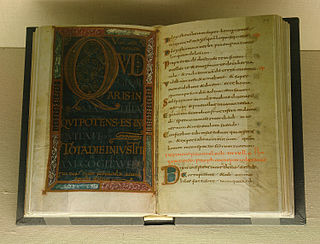
A psalter is a volume containing the Book of Psalms, often with other devotional material bound in as well, such as a liturgical calendar and litany of the Saints. Until the emergence of the book of hours in the Late Middle Ages, psalters were the books most widely owned by wealthy lay persons. They were commonly used for learning to read. Many Psalters were richly illuminated, and they include some of the most spectacular surviving examples of medieval book art.

The Vespasian Psalter is an Anglo-Saxon illuminated psalter decorated in a partly Insular style produced in the second or third quarter of the 8th century. It contains an interlinear gloss in Old English which is the oldest extant English translation of any portion of the Bible. It was produced in southern England, perhaps in St. Augustine's Abbey or Christ Church, Canterbury or Minster-in-Thanet, and is the earliest illuminated manuscript produced in "Southumbria" to survive.

In a written or published work, an initial capital, also referred to as a drop capital or simply an initial cap, initial, initcapital, initcap or init or a drop cap or drop, is a letter at the beginning of a word, a chapter, or a paragraph that is larger than the rest of the text. The word is derived from the Latin initialis, which means standing at the beginning. An initial is often several lines in height and in older books or manuscripts are known as "inhabited" initials. Certain important initials, such as the Beatus initial or "B" of Beatus vir... at the opening of Psalm 1 at the start of a vulgate Latin. These specific initials in an illuminated manuscript were also called initiums.
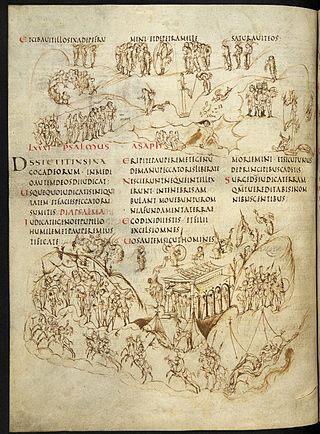
The Utrecht Psalter is a ninth-century illuminated psalter which is a key masterpiece of Carolingian art; it is probably the most valuable manuscript in the Netherlands. It is famous for its 166 lively pen illustrations, with one accompanying each psalm and the other texts in the manuscript. The precise purpose of these illustrations, and the extent of their dependence on earlier models, have been matters of art-historical controversy. The psalter spent the period between about 1000 to 1640 in England, where it had a profound influence on Anglo-Saxon art, giving rise to what is known as the "Utrecht style". It was copied at least three times in the Middle Ages. A complete facsimile edition of the psalter was made in 1875, and another in 1984 (Graz).

The Parker Library is a library within Corpus Christi College, Cambridge which contains rare books and manuscripts. It is known throughout the world due to its invaluable collection of over 600 manuscripts, particularly medieval texts, the majority of which were bequeathed to the college by Archbishop of Canterbury Matthew Parker, a former Master of Corpus Christi College.
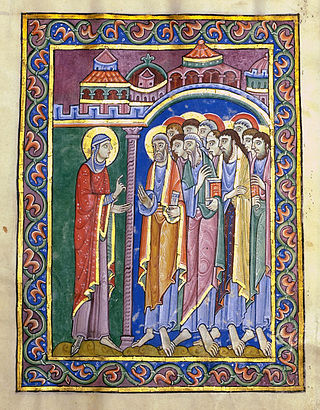
The St Albans Psalter, also known as the Albani Psalter or the Psalter of Christina of Markyate, is an English illuminated manuscript, one of several psalters known to have been created at or for St Albans Abbey in the 12th century. It is widely considered to be one of the most important examples of English Romanesque book production; it is of almost unprecedented lavishness of decoration, with over forty full-page miniatures, and contains a number of iconographic innovations that would endure throughout the Middle Ages. It also contains the earliest surviving example of French literature, the Chanson de St Alexis or Vie de St Alexis, and it was probably commissioned by an identifiable man and owned by an identifiable woman. Since the early 19th century it has been owned by the church of St. Godehard in Hildesheim, Lower Saxony in northwestern Germany, but is now stored and administered at the nearby Dombibliothek in Hildesheim Cathedral. A single leaf from the manuscript is at the Schnütgen Museum, Cologne; one further leaf, and one further cutting, are missing from the volume, their whereabouts unknown.

William de Brailes was an English Early Gothic manuscript illuminator, presumably born in Brailes, Warwickshire. He signed two manuscripts, and apparently worked in Oxford, where he is documented from 1238 to 1252, owning property in Catte Street near the University Church of St Mary the Virgin, roughly on the site now occupied by the chapel of All Souls College, where various members of the book trade lived. He was married, to Celena, but evidently also held minor orders, as at least three self-portraits show him with a clerical tonsure. This was not unusual: by this date, and with the exception of the St. Albans monk Matthew Paris, the only other English illuminator of the period about whom we have significant personal information, most English illumination seems to have been done in commercial workshops run by laymen.

The Psalter of Oswald also called the Ramsey Psalter is an Anglo-Saxon illuminated psalter of the last quarter of the tenth century. Its script and decoration suggest that it was made at Winchester, but certain liturgical features have suggested that it was intended for use at the Benedictine monastery of Ramsey Abbey, or for the personal use of Ramsey's founder St Oswald.
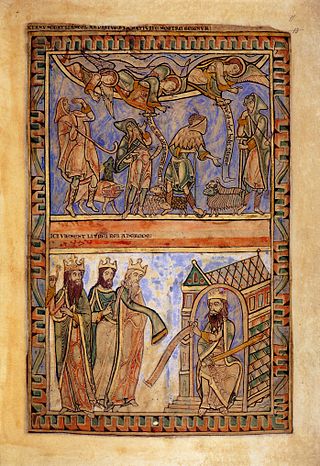
The Winchester Psalter is an English 12th-century illuminated manuscript psalter, also sometimes known as the Psalter of Henry of Blois, and formerly known as the St Swithun's Psalter. It was probably made for use in Winchester, most scholars agreeing that the most likely patron was the Henry of Blois, brother of Stephen, King of England, and Bishop of Winchester from 1129 until his death in 1171. Until recent decades it was "a little-studied masterpiece of English Romanesque painting", but it has been the subject of several recent studies.

Two lavishly illustrated illuminated manuscript psalters are known as the Psalter of Saint Louis as they belonged to the canonized King Louis IX of France. They are now in Paris and Leiden, and are respectively good examples of French Gothic and English Romanesque illumination.
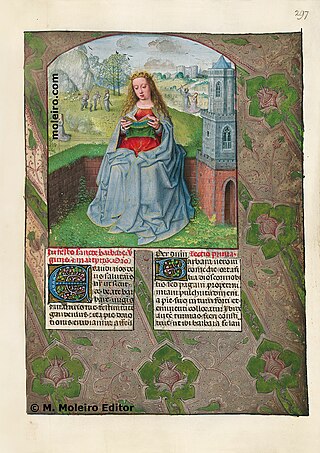
The Isabella Breviary is a late 15th-century illuminated manuscript housed in the British Library, London. Queen Isabella I of Castile was given the manuscript shortly before 1497 by her ambassador Francisco de Rojas to commemorate the double marriage of her children and the children of Emperor Maximilian of Austria and Duchess Mary of Burgundy.

The Howard Psalter and Hours is a 14th-century illuminated prayerbook. It includes a liturgical Psalter with canticles and litany, the Office of the Dead, a calendar of East Anglian origin and an incomplete Hours of the Passion. It was produced between 1310 and 1320. It is written in Latin in a Gothic script in two columns per page. There are 115 extant folios which measure 360 by 235 mm. The text block occupies an area of 250 by 166 mm. It is bound together with the De Lisle Psalter, a contemporary psalter.

The Queen Mary Psalter is a fourteenth-century English psalter named after Mary I of England, who gained possession of it in 1553. The psalter is noted for its beauty and the lavishness of its illustration, and has been called "one of the most extensively illustrated psalters ever produced in Western Europe" and "one of the choicest treasures of the magnificent collection of illuminated MSS. in the British Museum".

The Westminster Psalter, British Library, MS Royal 2 A XXII, is an English illuminated psalter of about 1200, with some extra sheets with tinted drawings added around 1250. It is the oldest surviving psalter used at Westminster Abbey, and is presumed to have left Westminster after the Dissolution of the Monasteries. It joined the Old Royal Library as part of the collection of John Theyer, bought by Charles II of England in 1678. Both campaigns of decoration, both the illuminations of the original and the interpolated full-page drawings, are important examples of English manuscript painting from their respective periods.

The Gorleston Psalter is a 14th-century manuscript notable for containing early music instruction and for its humorous marginalia. It is named for the town of Gorleston in Norfolk.

Beatus vir are the first words in the Latin Vulgate Bible of both Psalm 1 and Psalm 112. In each case, the words are used to refer to frequent and significant uses of these psalms in art, although the two psalms are prominent in different fields, art in the case of Psalm 1 and music in the case of Psalm 112. In psalter manuscripts, the initial letter B of Beatus is often rendered prominently as a Beatus initial.
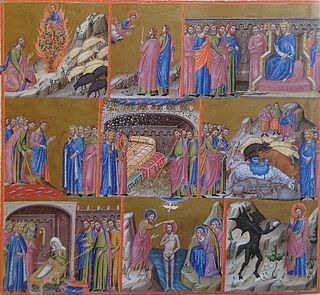
The Great Canterbury Psalter is an early 13th- and mid 14th-century illuminated manuscript with the shelfmark MS lat. 8846 in the Bibliothèque nationale de France in Paris. It was made in two different locations and moments in time: at Canterbury around 1200 and in Catalonia around 1340. It is the last of a series of copies of the Utrecht Psalter made in Canterbury, following the Harley Psalter and the Eadwine Psalter.
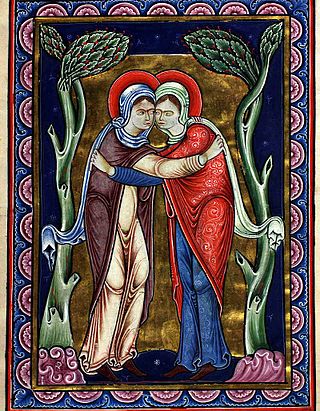
TheCopenhagen Psalter is a 12th-century illuminated manuscript psalter, made in England. It may have been created for the education of the boy king, King Canute VI of Denmark. This manuscript is known for the many artists who contributed to the full-page illuminations. The Copenhagen Psalter is currently in Denmark.
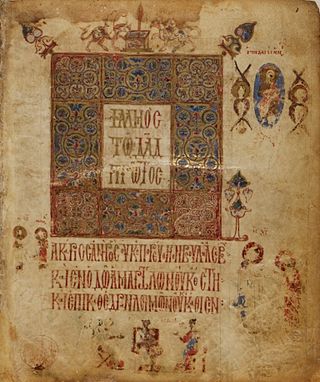
The Theodore Psalter is an illustrated manuscript and compilation of the Psalms and the canticles, or Odes from the Old Testament. "This Psalter has been held in the British Library since 1853 as Additional 19.352," wrote Princeton Art History professor Charles Barber in his first essay that is a companion to the Theodore Psalter E-Facsimile. Barber called the Psalter, "One of the richest illuminated manuscripts to survive from Byzantium."




















